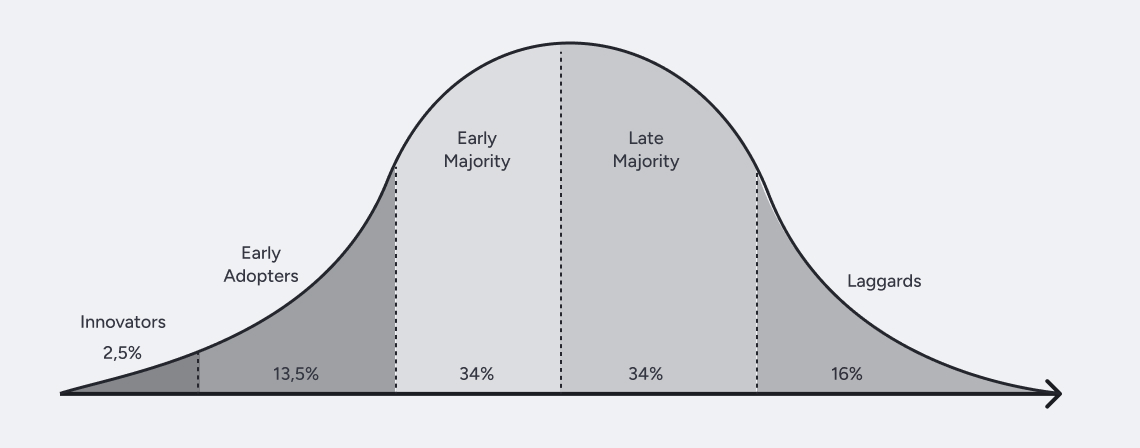I’ve heard countless stories about design systems that never got off the ground or, even when implemented, failed to achieve good adoption rates within companies. Most design systems don’t fail due to technical issues but rather due to a lack of understanding of their true value. The core problem isn’t in the components, documentation, or code quality — it lies in the organizational culture that should support them. And the truth is, this fate is often sealed right from the early planning stages.
Design Systems Are About People (Once Again!)
A design system is not just a set of components, style guides, processes, and code standards. It is often a massive shift in how teams collaborate, make decisions, and build products. It is a new language that spreads across different departments, from design and development to product and marketing.
When we treat design systems purely as technical artifacts, we miss the main point: they exist to facilitate communication between people and align different perspectives. Each component tells a story about the decisions we make and the values we uphold.
So, my dear friends, a design system directly impacts culture because it changes how people work. It demands consistency where there was once chaotic freedom, collaboration where silos existed, and trust where improvisation ruled.
Culture Cannot Be Changed by Decree
Trying to “force” a design system onto a team is like trying to fit a puzzle piece in the wrong place—brute force won’t help, it will only frustrate. Adoption happens when those involved are already prepared, when they see the value in the system even before it exists.
So, to my fellow designers, who often lead these projects, I ask you to remember the basic rules of experience design: involve users in every phase of research, definition, planning, and implementation.
“Evangelization Begins Long Before the Design System Exists”
Every time I say this to someone, I see a lightbulb go off above their head, as if they suddenly realize something crucial: because it is an internal product, those responsible for it often overlook the importance of understanding and preparing its users. Processes based on double or triple diamond frameworks? Let’s just say everything gets compressed into a single, flashy 2-carat diamond.
The success of a design system does not depend solely on flawless execution but on fertile ground—a cultural foundation that comes from what I call “silent evangelization.”
This process isn’t about shouting the system’s benefits from a stage or stacking slides in a corporate presentation. It’s about building understanding, aligning expectations, and creating a collective sense of purpose long before the design system takes shape. Without this, it remains just a beautiful promise that no one knows how to fulfill.
You Can’t “Push” Culture
Trying to impose a design system without prior cultural preparation is like planting seeds in dry soil because:
1. Culture is organic, not mechanical. Changes happen through:
- Shared narratives
- Collective experiences
- Repeatedly demonstrated valuesTangible, understandable, and relevant benefits
None of these can simply be imposed or accelerated by decree.
2. According to Everett Rogers’ Diffusion of Innovation Theory, adoption follows a natural curve:

Trying to force everyone to adopt simultaneously ignores this sociological reality and creates resistance.
3. There’s a paradox of psychological ownership.
People support what they help create. A design system that doesn’t incorporate the voices of the teams using it will always be seen as “their system” rather than “our system.”
Pre-Design System Evangelization Strategies
Even before defining anything, carry out activities that introduce design system users to its context of implementation.
1. Document and Share the Current Pain Points
Talk to users to map out:
- Concrete examples of inconsistencies in products
- Time lost in rework
- The impact of non-standardized processes
- How lack of standardization affects user experience
- The financial cost of the current inefficiency
2. Awareness Workshops
Host interactive sessions where teams:
- Analyze the current fragmentation of user experience
- Identify similar components existing in multiple variations
- Discuss how other companies solved similar problems
- Imagine what their work would look like with a unified system
3. Small Incremental Wins
Before proposing a full design system:
- Standardize simple, non-controversial elements
- Demonstrate value through specific use cases
- Celebrate and document efficiency improvements
- Use these wins as narratives to justify larger efforts
4. Build a Community, Not Just Tools
Create spaces (physical or virtual) where:
- Designers and developers can share challenges
- The common language of the future design system begins to take shape
- Ideas and solutions emerge organically
- People feel part of something bigger than their daily tasks
Finally, Measure the Success of Evangelization
Measuring evangelization efforts is crucial, so you can make informed decisions about the next steps. You’ll notice positive signs when:
- Teams start using consistent terminology for interface elements
- There are spontaneous requests for patterns in areas not yet addressed
- People from different departments voluntarily participate in design system discussions
- Resistance shifts from “Why do we need this?” to “When will we have this?”
Remember: evangelization is a continuous process. That’s why it’s essential to identify and empower allies and ambassadors who naturally drive adoption. Genuine change happens horizontally, not from top-down imposition.
